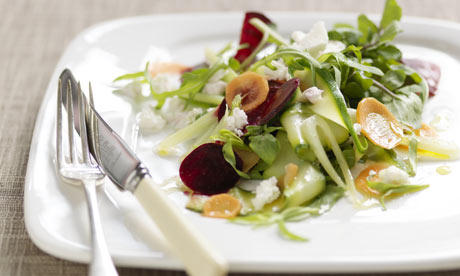
Barny Haughton's barleywood garden salad with walnut oil dressing
This is a salad of almost raw vegetables with salad leaves and herbs. Use whatever is seasonal. The vegetables should be very thinly sliced - almost wafer thin. They should be well washed, peeled and the root vegetables left in cold water. But keep the beetroot away from everything until the very last minute.
For the salad:
4 scrubbed baby beetroot
1 bulb fennel
2 courgettes
2 peeled carrots
Handful of fresh, podded, baby broad beans and/or peas
A large handful peppery salad leaves (rocket, watercress, mustard leaves etc)
Small bunch of mint, tarragon or marjoram
350g soft, crumbly goat's cheese or feta
For the dressing:
5 tbsp walnut oil
2 tbsp olive oil
1 tbsp white wine vinegar
Salt and pepper
Make the dressing. Whisk together both oils with the vinegar and season to taste. Set aside.
Slice the vegetables very thinly, following the natural shape of each one. If they are very big, cut a circular slice and cut that into more manageable slices. Then plunge the sliced vegetables, each type at a time, into plenty of boiling salted water for about three seconds. Spread on to a plate to cool and sprinkle them with a little salt and lemon juice. Leave the vegetables unchilled but covered with a cloth.
Wash the salad leaves and herbs and dry gently. Prepare the beetroot and slice thinly as above. Blanch in boiling salted water as above and spread on to a separate plate, again sprinkled with a little salt and lemon juice. Wash your hands.
In a large bowl, toss the sliced vegetables in the dressing. They should be quite limp, but still colourful. Add the salad leaves and herbs and toss very gently. Arrange the beetroot slices about randomly and scatter a couple of pinches of sea salt. Top with crumbled goat's cheese.
Allegra McEvedy's veal, mozzarella and mushroom lasagne
This is a soupier version, almost broth-like in its stock levels. Forget the mince, tomato sauce and bechamel - this is lighter, healthier and easier to make.
225g radicchio
2 tsp dried oregano
6 tbsp extra virgin olive oil
1.5 litres chicken stock - or 1 stock cube dissolved in 1.5 litres boiling water)
12 sheets, 250g dried lasagne (the one you don't need to pre-cook)
6 x 100g pieces Bocaddon Farm veal escalopes, beaten to around 1-2cm thick
150g wild mushrooms (choose small, pale mushrooms eg, chanterelles) - washed
2 cloves garlic - chopped
Big handful flat-leaf parsley - chopped
250g Laverstoke Park mozzarella - grated
140g parmesan - grated
Salt and pepper
Preheat the oven to 180C/350F/gas mark 4. Heat half the olive oil in a frying pan and saute the mushrooms for a couple of minutes. Add the garlic and parsley, season, toss, fry for a minute more until you can smell the garlic, then set aside. Split the radicchio down the middle and remove the core. Wash the leaves and drain well. Shred the radicchio into thin strips and set aside.
Put the veal pieces into a medium-sized bowl. Dress them with oregano, salt and pepper and the rest of the oil. Heat the chicken stock. Lay three sheets of lasagne on the bottom of a lasagne dish (20cm x 30cm x 5cm deep) and top these with a scattering of mushrooms and two of the veal pieces. Sprinkle on a quarter of the radicchio, followed by a quarter of the mozzarella and parmesan. Season with salt and pepper.
Lay down another three sheets of lasagne and repeat so that you finish the top layer with just radicchio and two kinds of cheese. Gently pour over the stock, aiming for a thin stream around the sides. Cover with foil and bake in the oven for 45 minutes. The stock will cook the lasagne and keep it moist. Serve with a big green salad.
Oliver Rowe's lemon posset
Lemon posset is an excellent spring dessert. The tartness of the lemon is underpinned by the richness of the cream. How sweet or tart you want it is up to you, but if you like it sweeter it works better if served with another tart fruit, such as bottled gooseberries or rhubarb compote. It's the most elegant of desserts, and one of the easiest to make.
300ml Rachel's organic double cream
75g caster sugar
2 lemons
Remove the zest from one of the lemons, put aside, then juice both lemons. Place the zest and juice in a saucepan along with the sugar and cream. Heat gently, stirring occasionally, until gently boiling. The common consensus of opinion is that three minutes' simmering is right, with which I would concur. Pour into serving glasses and chill in the fridge until set.
Allegra McEvedy, Barny Haughton and Oliver Rowe are all taking part in live chef demonstrations at the festival. For a full demos diary, visit realfoodfestival.co.uk.

